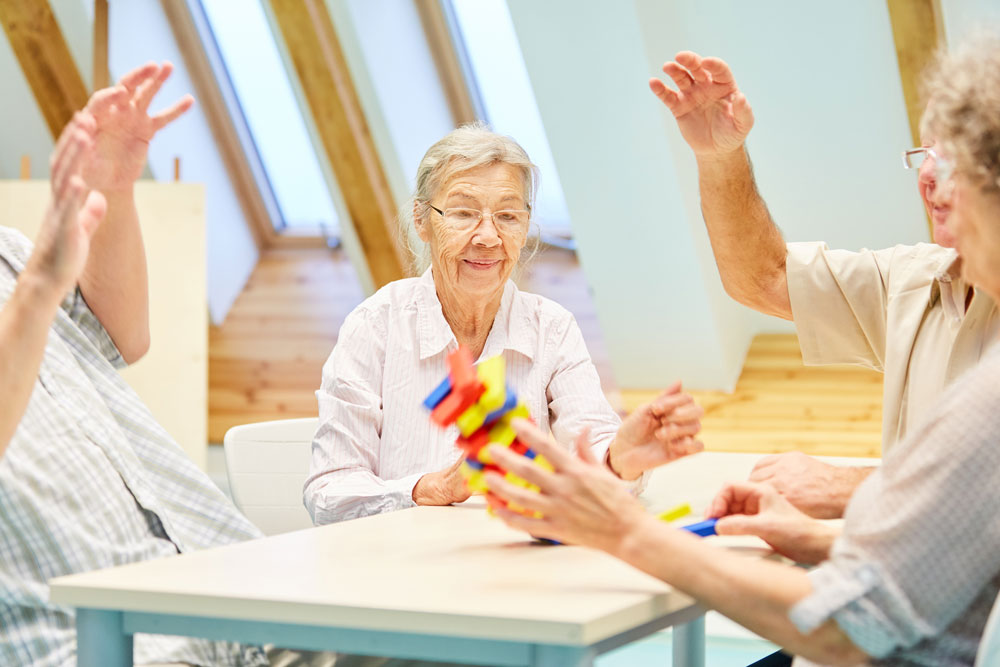All nursing homes have residents living with dementia.
This article is written based on Swedish conditions. Hopefully, it can inspire interested parties from other countries.
Those who live in nursing homes often have a dementia disease that affects their lives. With knowledge about dementia, we can facilitate everyday life and reduce the risk of worry and anxiety. Disease progression and symptoms are related to the type of dementia the resident has. With knowledge, response and adapted activities, it is possible to create a good everyday life.
 Foto: Mostphotos
Foto: MostphotosI received a comment on a previous article. Love this you write exactly like this is how it should be....working at a dementia care home and there we follow their rhythm not create a bunch of routines for the staff's sake no day is like the other. Living until you die....in your own way...have a good day Ingela
In case of suspicion of dementia, a thorough investigation should always be conducted by a doctor
In case of suspicion of dementia, a basic dementia investigation is done. It is based on medical history, current situation, functional and activity ability, conversation with relatives, cognitive ability tests and sampling. If necessary, a CT scan of the brain is performed. The examination needs to be done to exclude other diseases that can cause cognitive impairment.
If it is still not possible to establish a diagnosis, further investigation is conducted in the form of neuropsychological tests, MRI, lumbar puncture and possibly a functional brain imaging with SPECT.
Many different types of dementia diseases
Alzheimer's disease, frontal lobe dementia, Lewy body dementia and Parkinson's disease with dementia are due to brain cells withering and dying. In Alzheimer's, the parietal and temporal lobes are affected, in frontal lobe dementia the frontal and temporal lobes are affected, in Lewy Body dementia and Parkinson's disease with dementia it is the white matter in the brain that withers. These diseases usually have a creeping course. Vascular diseases in the brain, on the other hand, usually have a rapid course. Blood clots and strangled oxygen supply in the brain come suddenly often after a stroke.
Dementia caused by for example Syphilis, HIV, alcohol abuse and dementia caused by solvents are called secondary dementia diseases. These are diseases that can but not necessarily always turn into a dementia state.
In addition, mixed dementia can be seen in some. Dementia diseases cause great suffering for the individual and their relatives, but are also associated with large societal costs. An early investigation is important in order to quickly implement measures.
Approach and attitude when working with people living with dementia
Different dementia diseases require different approaches. It can affect both the resident in social contacts at the unit, relatives and employees. Causes of behavioral and psychological symptoms need to be investigated. Sometimes it can be good to bring in guidance from for example a BPSD team to get perspective on how employees can meet the resident in order for the care to become better.
Activities important for people with dementia
Meaningful daily activities and individual physical training in the form of for example weights, walking-balance- and movement training improve the everyday life for people with dementia. If a person despite measures needs medication treatment with anxiety reducing or antipsychotic drugs, the treatment time should be short. Effect and side effects are evaluated within a couple of weeks.
All care, nursing and care for people with dementia is based on a person-centered approach and that the work around people with dementia is conducted interprofessionally. By person-centered nursing is meant that the person and not the disease is put in focus. Person-centered nursing is expected to lead to a reduction of antipsychotic drugs.
Design of the accommodation
An elderly home for people with dementia should be designed in a way that promotes their well-being, safety and independence as much as possible. Here are some key factors to consider:
Safety: The elderly home should be designed with the thought that people with dementia can be vulnerable and forgetful. There needs to be conditions to ensure that residents do not unnoticed disappear from the elderly home and come to harm. It is also important with fire and safety systems. Often color setting can facilitate orientation as well as pictures of the resident outside the apartment door. Long corridors should be avoided as they can trigger so-called wandering behavior.
Homelike environment: The accommodation should mimic a homelike environment instead of an institutional feeling. This can include small departments or apartments with common living rooms, gardens, living rooms and own furnishing to create a feeling of safety and familiarity.
Clear and understandable layout: It is important with a clear and understandable layout, since people with dementia often can have difficulties navigating and maintaining orientation. This can include clear signs, color-coded areas or different themes that help identify different parts of the accommodation.
Adapted interior and equipment: The interior should be adapted to facilitate life for people with dementia. For example, it can be useful with contrasting colors, clear lighting, anti-reflective material and furniture without sharp corners to reduce the risk of accidents and improve visibility. In addition, equipment like memory aids, like pictures, symbols or whiteboards, can be beneficial.
Activity and stimulation opportunities: An elderly home for people with dementia should have activity and stimulation opportunities that promote well-being and stimulate both physically and mentally. This can include common activity rooms, gardens, hobby rooms and activity programs that are adapted to the individuals' interests and abilities.
Person-centered care: The care staff should have special competence and knowledge about dementia and be trained to be able to meet the residents' individual needs. It is important to offer person-centered care that promotes a feeling of dignity and independence for the residents.
Many elderly homes are not built with current knowledge about how a good care environment for people with dementia should look. It is still possible to do a lot to adapt the accommodation to those with dementia. The people living at the accommodation are in different stages of dementia, but it can be important to keep in mind that the accommodation should be adapted to those who have come furthest in the disease development. These tend to often become more sensitive to various sensory impressions. Sharp sounds, cluttered color settings, messy furnishing can mean that their functional ability deteriorates faster as their brains cannot handle the visual impressions.
Beautifully served food stimulates to eat by oneself, but a motley table setting can disturb the ability to orientation and thereby the meal peace. Preferably clear functional furnishing so that not TV-watching disturbs during mealtime etc. Do not clatter with porcelain during meals etc. One way to maintain circadian rhythm can be to dim the lighting gradually before bedtime. Flowers as decoration is restful for the eye while "modern art" can create unrest.
Aids at dementia disease
People with dementia often use the same aids as other residents.
There are a range of different aids that people with dementia can benefit from. Here are some examples:
Memory aids: This can include calendars, clocks or digital apps that help people with dementia keep track of the time and date. It can also include reminder apps or sound recordings to remind of important events, medication or daily routines.
GPS trackers: People with dementia can benefit from GPS trackers that can be attached to clothes or worn as bracelets or necklaces. These help to keep track of where the person is and can be useful if they get lost or cannot find home.
Electronic locks: Electronic locks where the resident enters their own apartment by carrying a tag that unlocks the door as the resident gets close.
Image- or color-coded aids: These can be helpful for people with dementia to recognize and find things. For example, color-coded key tags or pictures on boxes showing their content can facilitate for these people to find what they need.
Two-way communication devices: This can be useful to give people with dementia the opportunity to communicate with their caregivers or relatives in a simple way, even if they cannot use a regular phone. This can also be a way to limit the risk of being called by swindlers
Clothes for people with dementia disease
There are also special clothes that are specially designed for people with dementia disease. These garments are usually designed to facilitate dressing and make it more comfortable for people with dementia to handle clothes.
- It can be clothes with simple fastening such as magnetic buttons or velcro instead of traditional buttons.
- Clothes with wide openings: Clothes with wide openings, such as around the neck or sleeves, can facilitate for people with dementia to put on and take off the clothes.
- Clothes without loose parts: Clothes without loose strings, bands or accessories reduce the risk that the person can get stuck or stumble on these.
- Clothes in soft and comfortable materials: Soft and comfortable materials, like cotton or fleece fabric, can be more comfortable for people with dementia to wear.
- Clothes that have clear markings, for example color coding or marks to indicate front and back, can facilitate for the person to dress themselves.
- It can be good to use clothes that can handle 60 degree washing.
There are also other clothes that can facilitate the care for example so-called bodysuits that can contribute to facilitate the handling of incontinence aids.
It is important to note that the aids should be adapted individually after the person's needs and abilities. Aids must never be experienced as coercion by the individual.
Education for those who want to know more
There is good education when it comes to dementia. One example is Dementia ABC provided by Dementia Center.
There is a lot happening in the dementia area. This applies to both what we can do to slow down the progress. In a few years, there might be a dementia robot that can make a safe diagnosis early.
Reflection questions - dementia disease
Care staff:
- Have you undergone dementia center's dementia education?
- Do you have good support from licensed staff?
- What do you find most difficult in the care of people with dementia diseases?
Manager, nurse, occupational therapist and physiotherapist:
- Do you have good team cooperation around residents with dementia diseases?
- Do you have any weak points?
- In what way can you develop your working method during the coming year?
Resident and relative:
- Do the employees have a good approach to residents with dementia disease?
Erland Olsson
Specialist nurse
Sofrosyne - Better care every day

Aktuellt i media
-
2025-04-14 04:00
08 Förebyggande o lokaler
The art of furnishing a nursing home, a balancing act between homeliness, functionality, and hygiene aspects.
info -
2025-04-10 04:00
04 Bemötande
Waking up in a nursing home - is the morning routine adapted to each individual's needs?
info Bild: Pixabay
Bild: Pixabay -
2025-04-07 04:00
09 Mat och måltid
For the elderly, it is often important to eat many snacks in order to get enough nutrition.
info Bild: Pixabay
Bild: Pixabay -
2025-04-03 04:00
04 Bemötande
What creates safety in elderly care homes - advice and tips on creating a secure environment for the residents
info -
2025-04-01 00:00
10 Aktivitet o funktionsbevarande arbetssätt
Reminiscing, working with memories, is an activity that creates a lot of added value for people with dementia.
info - 2025-03-31 04:00 05 Planering

